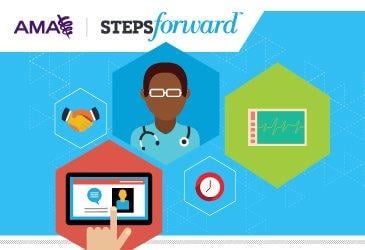Preparing the necessary clinical information for a patient visit is time-consuming—and for physicians, time is precious. Leveraging the skills and training of practice staff can cut down on the amount of time you need to dedicate to patient rooming and discharge, allowing you more time for direct patient care. Learn how.
Why you should expand your protocols for rooming and discharge
With expanded rooming and discharge protocols, nurses, medical assistants and other clinical support staff are able to fully use their skills to create a smooth visit for the patient and a satisfying clinic session for the entire team. Creating standard work routines enables team members to take on additional responsibilities that give physicians more time to spend on work for which they were uniquely trained.
Expanded rooming and discharge can increase efficiency, often saving about an hour or more of physician time per day.
A free online module in the AMA’s STEPS Forward collection shows you how to take steps to expand rooming and discharge. Visit the module to calculate what your practice could save.
What’s involved
As part of the expanded rooming protocol, the nurse or medical assistant can complete the following tasks:
- Identify the reason for the visit and help the patient set the visit agenda
- Perform medication reconciliation
- Screen for conditions based on protocols
- Update past medical, family and social history
- Provide immunizations based on standing orders
- Arrange for preventive services based on standing orders
- Assemble medical equipment, if needed, before the physician enters the exam room
Conducting these activities during patient rooming lets the physician spend more time directly interacting with the patient and family.
When it comes to patient discharge, the nurse or medical assistant can complete the following tasks:
- Print and review an updated medication list and visit summary
- Reiterate to patients the medical instructions prescribed by the physician
- Coordinate the next steps of care
This augmented discharge process ensures patients understand and remember their discharge instructions, leading to improved treatment adherence.
How changed protocols helped a primary care physician
Wisconsin internal medicine physician Richard Fossen, MD, implemented expanded rooming and discharge in his clinic.
“It is difficult at first to give up those things that you always used to do,” he said. “There’s work that only the provider can do for the patient, but then there’s a lot of other work that needs to get done, too. Delegating some of those roles to other people on the team has led to better patient care because those people can provide that education, or those pieces of patient care, just as well—if not better—than I can.”
Now Dr. Fossen has more time to care for patients, which has been beneficial across the board.
“This has led me to a place where I’m much more satisfied with my practice, much more satisfied at the end of the day,” he said. “I have a lot more time with my family, my staff is much more satisfied with the roles they’re playing in patient care and then my patients love it because they’re getting a lot better care.”
Read real-world stories in the module from physicians who implemented these improvements in their practices and saw big results. You also can find information about how to get support for implementing these changes. The module offers continuing medical education credit.




